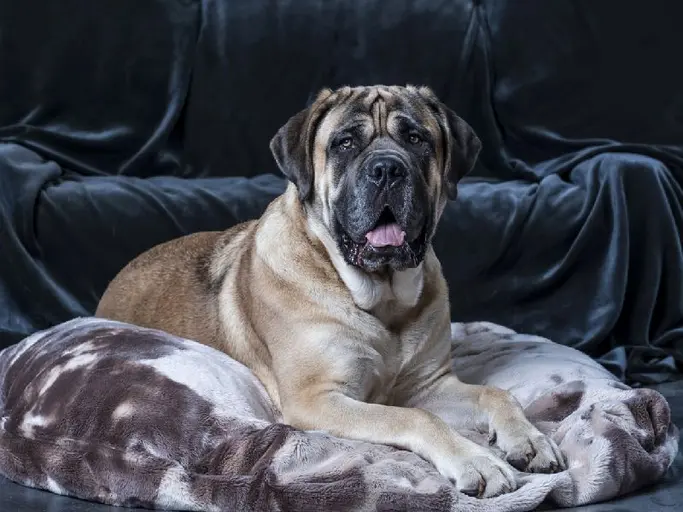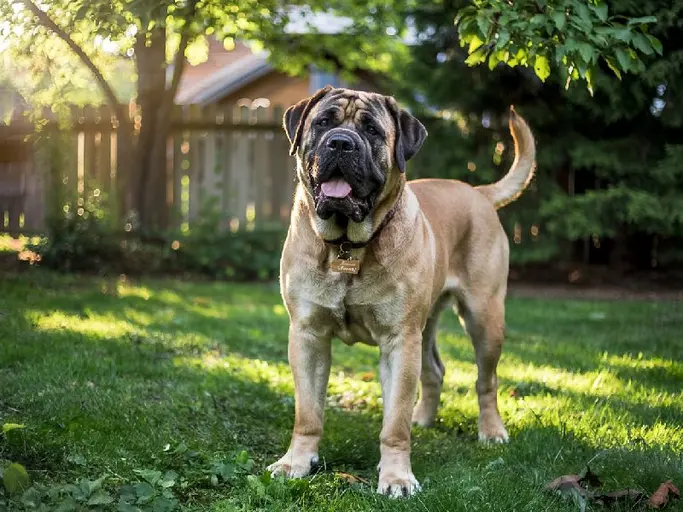The Gentle Giant: An Expert Guide to the Mastiff Dog Breed

Brief Introduction: The Majestic Mastiff
The Mastiff, often referred to as the Old English Mastiff, is a breed that truly embodies the term “gentle giant.” These dogs are known for their impressive size, dignified demeanor, and unwavering loyalty. While their imposing stature may initially seem intimidating, Mastiffs are generally calm, affectionate, and surprisingly sensitive. Their wrinkly face, dark mask, and powerful build make them instantly recognizable and a favorite for those seeking a devoted and protective companion. What makes the Mastiff attractive is their unique blend of power and gentleness which offers owners both security and loving attachment.
Breed History: From Ancient Warriors to Family Companions
Origins and Early Roles
The history of the Mastiff is long and fascinating, dating back to ancient times. Dogs resembling Mastiffs have been depicted in artwork and writings from as far back as the Roman Empire. It is believed they descended from ancient Molosser-type dogs, large war dogs used by various civilizations for guarding, fighting, and hunting. These early Mastiffs were prized for their courage, strength, and tenacity.
Evolution and Development
Over the centuries, the breed continued to evolve, primarily in England. They were used as guard dogs for estates, protectors of livestock, and even bear-baiting dogs. Their role in English society was significant, and they were highly valued for their loyalty and guarding capabilities.
Modern Mastiffs
The Mastiff breed nearly became extinct after World War II, but thanks to the dedication of breeders, they were saved. Today, Mastiffs are primarily kept as family companions.
Appearance: A Picture of Power and Dignity
Size and Build
Mastiffs are one of the largest dog breeds in the world. Males typically stand 28-30 inches (71-76 cm) tall at the shoulder and weigh 160-230 pounds (73-104 kg). Females are slightly smaller, standing 27-29 inches (69-74 cm) and weighing 120-170 pounds (54-77 kg). Their build is massive and muscular, conveying a sense of immense power.
Coat and Color
The Mastiff has a short, dense coat that is relatively easy to care for. Common coat colors include:
- Fawn
- Apricot
- Brindle
Regardless of coat color, all Mastiffs have a black mask around their muzzle and eyes, which is a distinctive feature of the breed.
Head and Facial Features
The head of a Mastiff is broad and massive, with a wrinkled forehead and a short, square muzzle. Their dark, soulful eyes express intelligence and gentleness. The ears are V-shaped and drop forward, framing their face.
Tail
The tail is set high and tapers to a point, reaching to the hocks. It is typically carried down but may be raised when the dog is alert or excited. Tail carriage provides an indication of the mood of the dog.
Character and Behavior: The Gentle Giant’s Heart
Temperament and Personality
Despite their imposing size, Mastiffs are known for their gentle and affectionate nature. They are calm, dignified, and fiercely loyal to their families. They are also surprisingly sensitive and responsive to their owner’s emotions.
Attitude Towards People
Mastiffs are generally good with people, especially their families. They are naturally protective and will instinctively guard their home and loved ones. Early socialization is essential to ensure they are comfortable around strangers.
Interaction with Children
Mastiffs can be excellent family dogs and are often good with children. However, due to their size, supervision is always necessary, especially with young children, to prevent accidental injury. Teaching children how to interact respectfully with the dog is also crucial.
Relationship with Other Animals
With proper socialization, Mastiffs can coexist peacefully with other animals. Early exposure to other dogs and cats is crucial to establish positive relationships. However, their size and prey drive may make them less suitable for homes with small pets, such as rabbits or rodents, unless they have been raised together from a young age.
Activity Level and Exercise Needs
While Mastiffs are not high-energy dogs, they still require regular exercise to maintain their physical and mental health. Daily walks are essential, and playtime in a securely fenced yard is beneficial. However, avoid strenuous exercise, especially during hot weather, as they are prone to overheating. Moderate exercise is best, especially when they are young to avoid putting too much strain on their joints
Trainability and Intelligence
Mastiffs are intelligent but can be stubborn and independent. Training requires patience, consistency, and positive reinforcement techniques. Early socialization and obedience training are essential to ensure they develop into well-behaved and confident adults.

Care and Maintenance: Ensuring a Happy and Healthy Mastiff
Grooming Needs
Mastiffs have a short coat that requires minimal grooming. Regular brushing once or twice a week will help remove loose hair and keep their coat healthy. Bathing should only be done when necessary, as frequent bathing can dry out their skin. Be sure to thoroughly dry the folds of skin on their face to prevent infection.
Exercise Requirements
As mentioned earlier, Mastiffs need moderate exercise to stay healthy. Daily walks of 20-30 minutes are usually sufficient. Puzzle toys and interactive games can also provide mental stimulation. Avoid over-exercising puppies, as this can damage their developing joints.
Diet and Nutrition
A high-quality dog food formulated for large breeds is essential for Mastiffs. Feed them a balanced diet that meets their nutritional needs. Monitor their weight and adjust their food intake as needed to prevent obesity, which can exacerbate joint problems. A balanced diet including protein, vitamins and minerals is essential for appropriate growth and wellbeing.
Health Concerns
Mastiffs are prone to certain health problems, including:
- Hip and elbow dysplasia
- Gastric torsion (bloat)
- Cardiomyopathy (heart disease)
- Cancer (osteosarcoma)
- Entropion and ectropion (eyelid problems)
Regular veterinary checkups are crucial to detect and manage these health issues. Responsible breeders will screen their dogs for these conditions to minimize the risk of passing them on to their offspring.
Breed Weaknesses: Considerations Before Getting a Mastiff
Potential for Aggression
While Mastiffs are generally gentle, their protective instincts can lead to aggression if not properly socialized and trained. Early socialization and obedience training are crucial to ensure they are comfortable around strangers and other animals. This will minimiseaggression risk.
Loyalty and Dependence
Mastiffs are extremely loyal and devoted to their families, which can sometimes lead to separation anxiety if left alone for extended periods. Providing them with plenty of attention, exercise, and mental stimulation can help prevent this.
Specific Weaknesses
Besides the health issues already mentioned, Mastiffs are also prone to:
- Drooling: Mastiffs are known for their drooling, which can be messy.
- Sensitivity to heat: Mastiffs are prone to overheating due to their size and short muzzle.
- High cost of ownership: Due to their size, Mastiffs require a significant amount of food and veterinary care, making them an expensive breed to own.
Conclusion: Is a Mastiff the Right Breed for You?
The Mastiff is a magnificent and loving breed that can make a wonderful companion for the right owner. However, they are not the right choice for everyone. They require experienced owners who are willing to provide them with proper socialization, training, and care. If you are prepared to meet their needs and can provide them with a loving and supportive home, a Mastiff can bring you years of joy, loyalty, and protection. This large breed is best suited to someone who can give it the appropriate attention and care.
Frequently Asked Questions About Mastiff
-
What is the general temperament of a Mastiff?
Mastiffs are known for their gentle and affectionate nature. They are calm, dignified, and fiercely loyal to their families, often referred to as “gentle giants.”
-
How big do Mastiffs get?
Males typically stand 28-30 inches tall and weigh 160-230 pounds. Females are slightly smaller, standing 27-29 inches and weighing 120-170 pounds.
-
What are common coat colors for Mastiffs?
Common coat colors include Fawn, Apricot, and Brindle. All Mastiffs have a black mask around their muzzle and eyes.
-
Do Mastiffs require a lot of exercise?
While not high-energy, Mastiffs need regular exercise. Daily walks of 20-30 minutes are essential. Avoid strenuous exercise, especially in hot weather.
-
Are Mastiffs good with children?
Mastiffs can be excellent family dogs and are often good with children. Supervision is necessary due to their size, especially with young children.
-
What are some common health concerns for Mastiffs?
Common health issues include hip and elbow dysplasia, gastric torsion (bloat), cardiomyopathy (heart disease), cancer (osteosarcoma), and eyelid problems like entropion and ectropion.
-
Are Mastiffs easy to train?
Mastiffs are intelligent but can be stubborn. Training requires patience, consistency, and positive reinforcement. Early socialization and obedience training are essential.
-
Do Mastiffs drool a lot?
Yes, Mastiffs are known for their drooling, which can be messy.
-
How much grooming do Mastiffs need?
Mastiffs have a short coat that requires minimal grooming. Regular brushing once or twice a week is sufficient. Bathing should only be done when necessary.
-
Are Mastiffs expensive to own?
Yes, due to their size, Mastiffs require a significant amount of food and veterinary care, making them an expensive breed to own.

